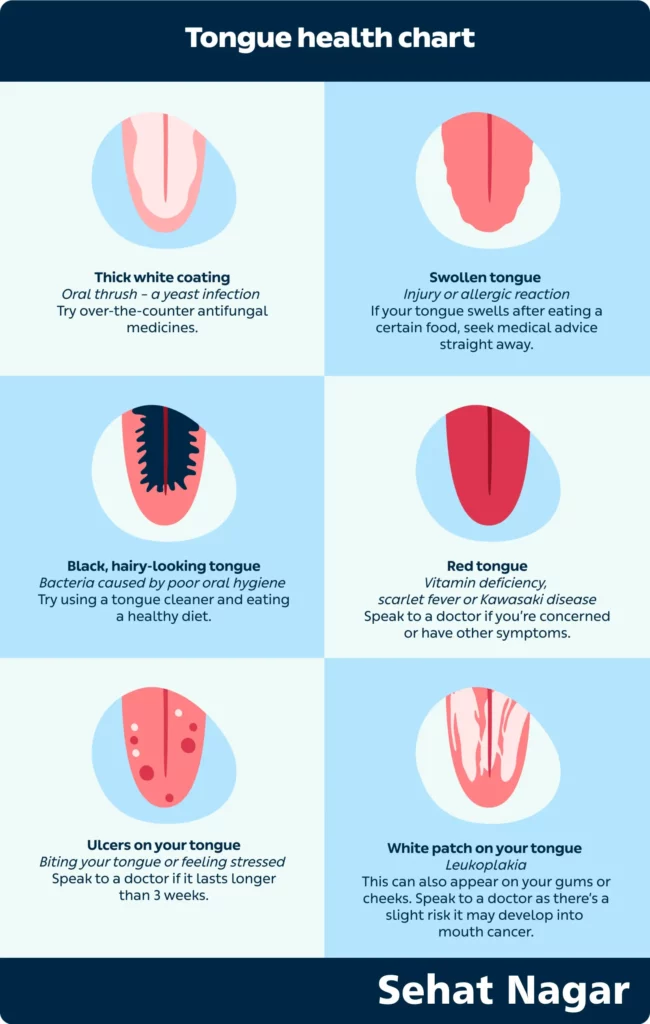


Did you know that our tongues can tell us a lot about our bodies? In traditional medicine, there is a special chart called the tongue diagnosis chart that helps us understand our health. It’s like a picture of the different parts of tongue, and by looking at these parts, we can learn about how our body is doing. The tongue diagnosis chart is important because it helps traditional medicine practitioners figure out what might be going on inside our bodies. They look at the color, coating, shape, and texture of our tongues to see if everything is okay or if there might be some problems. It is like a secret code that the tongue can tell us!
This special chart is used in traditional medicine systems like Traditional Chinese Medicine and Ayurveda. These medicines believe that our bodies are connected, and the tongue is like a small map that shows us what’s happening inside. By looking at the tongue, practitioners can see if something is too much or too little in our bodies and then suggest ways to make things better. This might include using special plants, acupuncture (which is when tiny needles are gently placed on the body), eating different foods, or changing our daily habits.
Understanding “Tongue Diagnosis Chart” is the main purpose of this article. We want to explore and learn more about this chart and how it can help us. Whether you are curious about your own health or want to know more about how traditional medicine works, this article will explain everything in an easy and fun way. So get ready to explore about tongue diagnosis and discover the amazing things our tongues can tell us about our bodies. Let’s learn together and have fun exploring this cool chart!
Tongue diagnosis is like a special tool that helps traditional doctors learn about our health. They look at our tongues to find clues about how our bodies are doing. In traditional medicine, like Traditional Chinese Medicine and Ayurveda, they believe that our tongues can show us what’s happening inside our bodies. Imagine your tongue as a mirror. When doctors look at it, they can see reflections of different body parts. They notice the color, coating, shape, and texture of our tongues to understand if everything is okay or if something needs attention.
Tongue diagnosis is not tough at all. It is based on simple ideas. One important idea is that our bodies need balance between different things. Doctors call them yin and yang energies. Yin is like coolness and rest, while yang is like warmth and activity. By looking at our tongues, doctors can tell if these energies are equal or if something is off. When doctors look at our tongues, they check for different things. They notice the color of our tongues, if there’s a coating on it, and even the shape and also texture. These things give them clues about our health and help them figure out what might be wrong.
So, tongue diagnosis is like a secret language that only doctors understand. They use it to learn about our bodies and find ways to make us feel better. It is a special tool that people use a very long time, and it helps us take care of our health in a smart way! Remember, our tongues are not just for tasting food. They can tell us so much about our bodies and help us stay healthy. So, next time you look in the mirror, say hello to your tongue and remember how special it is!
A tongue diagnosis chart is like a picture that helps doctors understand our tongues and what they can tell us about our health. Let’s explore the different parts of a tongue diagnosis chart in a simple way! The chart shows a picture of a tongue divided into different sections. Each section represents a special part of our body. It’s like a puzzle where each piece has a meaning. In the chart, you will see drawings that represent different things about the tongue. They show things like the color, coating, shape, and texture of the tongue. These things give doctors important information about our health.

For example, the chart might have colors like red, pink, or pale. These colors can show doctors if our bodies have enough energy or if we need more. They can also tell if we have too much heat or coldness in our bodies. The chart also shows the coating on the tongue. It might be thin, thick, white, or yellow. This coating can give doctors clues about how well our bodies are working. Shapes and textures are important too. The chart might show tongues that are swollen, thin, or have cracks. These things can tell doctors if there might be some problems with our organs or if we need to change our habits. When doctors look at our tongues, they compare what they see to the pictures on the chart. This helps them understand which part of our body might need some care or attention.
So, the tongue diagnosis chart is like a special picture that helps doctors understand what our tongues are saying about our health. It shows different things about the tongue and helps doctors know how to take care of our bodies. It’s a really neat tool that helps us stay healthy!
When doctors use the tongue diagnosis chart, they look at different characteristics of the tongue to understand what might be happening inside our bodies. Let’s explore some of the common tongue characteristics and what they can mean.
These characteristics are not standalone diagnoses but rather indicators that help doctors understand the overall health of our bodies. A combination of these characteristics, along with other symptoms and medical history, is considered for a comprehensive diagnosis.
By observing and analyzing these common tongue characteristics on the chart, doctors can gain valuable insights into our health and guide us towards appropriate treatments or lifestyle adjustments. Tongue diagnosis is a fascinating tool that allows doctors to understand our bodies in a unique way, helping us achieve better overall well-being.
Doctors use tongue diagnosis charts in different traditional medical systems around the world. Let’s learn how they to use it in Traditional Chinese Medicine (TCM), Ayurvedic medicine, and other traditional practices.
For example:
All these traditional medical systems believe that the tongue can tell us a lot about our health. By looking at the tongue, doctors can understand imbalances and suggest treatments to help us feel better. Using tongue diagnosis charts, doctors can easily compare what they see on the tongue to the pictures on the chart. This helps them understand the meanings behind different tongue characteristics and guide their treatments.
While tongue diagnosis is a helpful tool, it does have some limitations and challenges. Let’s talk about them in a way that’s easy for you to understand!
Remember, tongue diagnosis is just one part of the process. It’s important for doctors to look at many things to make sure they have all the information they need. Scientists and researchers are also working to find more evidence and make tongue diagnosis even better. They want to make sure it’s accurate and reliable for everyone. So, while tongue diagnosis is helpful, it’s important to remember that it’s not the only thing doctors use. They combine it with other methods to get a complete understanding of our health.
If you’re interested in using a tongue diagnosis chart, here are some tips to help you understand it better:
Make sure you have good light when looking at the tongue. It’s important to see the details clearly. Also, ask the person to open their mouth wide and stick out their tongue. This helps you get a good view of the tongue’s color, coating, shape, and texture.
To understand what the tongue tells us, we need to think about the person’s overall health. Things like their age, gender, and lifestyle can affect how the tongue looks. So, it’s important to think about everything together to get a better understanding.
Using a tongue diagnosis chart is helpful, but it’s always good to ask a trained professional for guidance. They can help you understand what the chart says and how it relates to your health. They can also give you advice on what to do next.
If you’re using the chart to track your own health, try to make your observations at the same time every day. Also, keep the position of your tongue consistent when looking at it. This way, you can notice any changes over time and understand if something is different or needs attention.
Tongue diagnosis is only one way to understand our health. It’s important to combine it with other things like asking about how you feel, doing physical exams, and maybe even doing tests. All these things together give a better picture of your health. Using a tongue diagnosis chart can be fun and helpful, but it’s always good to have someone knowledgeable guide you.
Read Also:
In the future, tongue diagnosis will become even more advanced. Scientists are developing better tools and cameras to get clearer pictures of the tongue, helping doctors see even tiny changes. Computers will use artificial intelligence and machine learning to analyze tongue images and learn more about how they relate to our health. This can make diagnoses more accurate and help doctors treat us better. Computers might even be able to give instant feedback on our tongue health. Technology will also allow us to show tongue pictures to doctors during video calls, making it easier to get advice from a distance. Scientists from different fields will work together to make sure these advancements are helpful and safe. Exciting times are ahead for tongue diagnosis and our overall health!
Read Also: Tongue Health Chart: The Link Between Oral Health And General Health
Tongue diagnosis charts provide a valuable tool in traditional medicine for assessing health conditions based on the characteristics of the tongue. By understanding the different components of a tongue diagnosis chart and the meanings behind common tongue characteristics, we can gain insights into our overall well-being. However, it’s important to remember the limitations and challenges of relying solely on tongue diagnosis, and the need to combine it with other diagnostic methods for a comprehensive evaluation.
As advancements continue to unfold, such as technological innovations, integration of artificial intelligence, and potential automated systems, the future of tongue diagnosis looks promising. These developments have the potential to enhance diagnostic accuracy, improve access to healthcare, and contribute to the integration of traditional medicine with modern healthcare systems. With collaborative research and validation efforts, we can ensure the credibility and effectiveness of these future innovations. By embracing the possibilities of technology while preserving the wisdom of traditional medicine, we can pave the way for personalized and holistic approaches to health and well-being.
Read Also: Where To Inject Botox For Lip Flip?